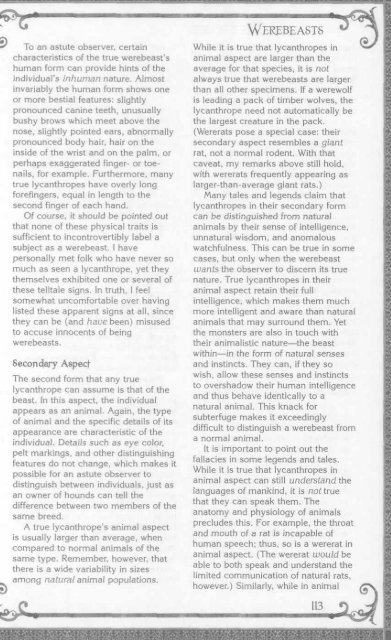Van Richten's Monster Hunter's.pdf - Askadesign.com
Van Richten's Monster Hunter's.pdf - Askadesign.com
Van Richten's Monster Hunter's.pdf - Askadesign.com
You also want an ePaper? Increase the reach of your titles
YUMPU automatically turns print PDFs into web optimized ePapers that Google loves.
.<br />
To an astute observer, certain<br />
characteristics of the true werebeast’s<br />
human form can provide hints of the<br />
individual’s inhuman nature. Almost<br />
invariably the human form shows one<br />
or more bestial features: slightly<br />
pronounced canine teeth, unusually<br />
bushy brows which meet above the<br />
nose, slightly pointed ears, abnormally<br />
pronounced body hair, hair on the<br />
inside of the wrist and on the palm, or<br />
perhaps exaggerated finger- or toenails,<br />
for example. Furthermore, many<br />
true lycanthropes have overly long<br />
forefingers, equal in length to the<br />
second finger of each hand.<br />
Of course, it should be pointed out<br />
that none of these physical traits is<br />
sufficient to incontrovertibly label a<br />
subject as a werebeast. I have<br />
personally met folk who have never so<br />
much as seen a lycanthrope, yet they<br />
themselves exhibited one or several of<br />
these telltale signs. In truth, I feel<br />
somewhat un<strong>com</strong>fortable over having<br />
listed these apparent signs at all, since<br />
they can be (and haue been) misused<br />
to accuse innocents of being<br />
werebeasts.<br />
Secondav Aspect<br />
The second form that any true<br />
lycanthrope can assume is that of the<br />
beast. In this aspect, the individual<br />
appears as an animal. Again, the type<br />
of animal and the specific details of its<br />
appearance are characteristic of the<br />
individual. Details such as eye color,<br />
pelt markings, and other distinguishing<br />
features do not change, which makes it<br />
possible for an astute observer to<br />
distinguish between individuals, just as<br />
an owner of hounds can tell the<br />
difference between two members of the<br />
same breed.<br />
A true lycanthrope’s animal aspect<br />
is usually larger than average, when<br />
<strong>com</strong>pared to normal animals of the<br />
same type. Remember, however, that<br />
there is a wide variability in sizes<br />
among natural animal populations.<br />
‘WEICBEASTS d<br />
While it is true that lycanthropes in<br />
animal aspect are larger than the<br />
average for that species, it is not<br />
always true that werebeasts are larger<br />
than all other specimens. If a werewolf<br />
is leading a pack of timber wolves, the<br />
lycanthrope need not automatically be<br />
the largest creature in the pack.<br />
(Wererats pose a special case: their<br />
secondary aspect resembles a giant<br />
rat, not a normal rodent. With that<br />
caveat, my remarks above still hold,<br />
with wererats frequently appearing as<br />
larger-than-average giant rats.)<br />
Many tales and legends claim that<br />
lycanthropes in their secondary form<br />
can be distinguished from natural<br />
animals by their sense of intelligence,<br />
unnatural wisdom, and anomalous<br />
watchfulness. This can be true in some<br />
cases, but only when the werebeast<br />
wants the observer to discern its true<br />
nature. True lycanthropes in their<br />
animal aspect retain their full<br />
intelligence, which makes them much<br />
more intelligent and aware than natural<br />
animals that may surround them. Yet<br />
the monsters are also in touch with<br />
their animalistic nature-the beast<br />
within-in the form of natural senses<br />
and instincts. They can, if they so<br />
wish, allow these senses and instincts<br />
to overshadow their human intelligence<br />
and thus behave identically to a<br />
natural animal. This knack for<br />
subterfuge makes it exceedingly<br />
difficult to distinguish a werebeast from<br />
a normal animal.<br />
It is important to point out the<br />
fallacies in some legends and tales.<br />
While it is true that lycanthropes in<br />
animal aspect can still understand the<br />
languages of mankind, it is not true<br />
that they can speak them. The<br />
anatomy and physiology of animals<br />
precludes this. For example, the throat<br />
and mouth of a rat is incapable of<br />
human speech: thus, so is a wererat in<br />
animal aspect. (The wererat would be<br />
able to both speak and understand the<br />
limited <strong>com</strong>munication of natural rats,<br />
however.) Similarly, while in animal


